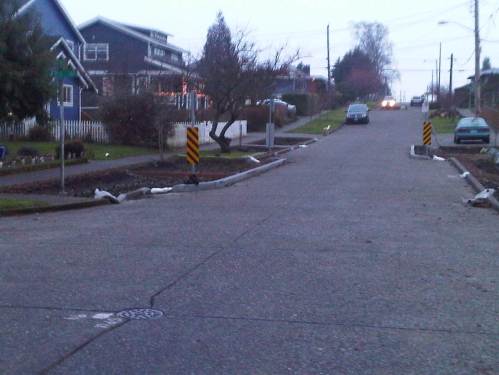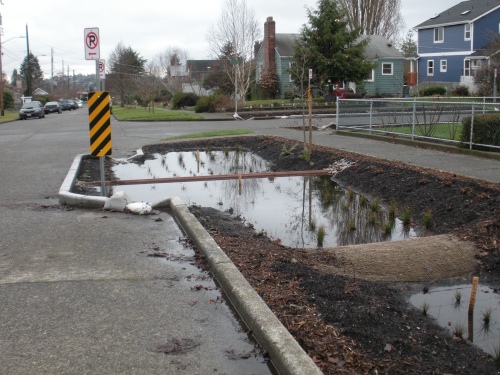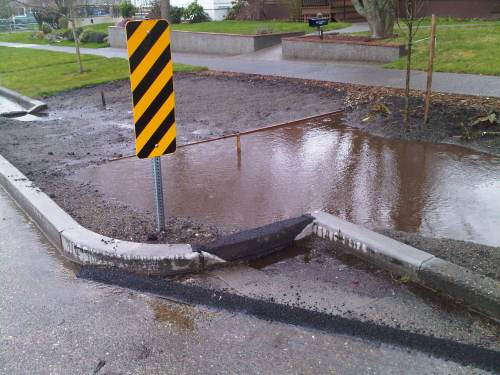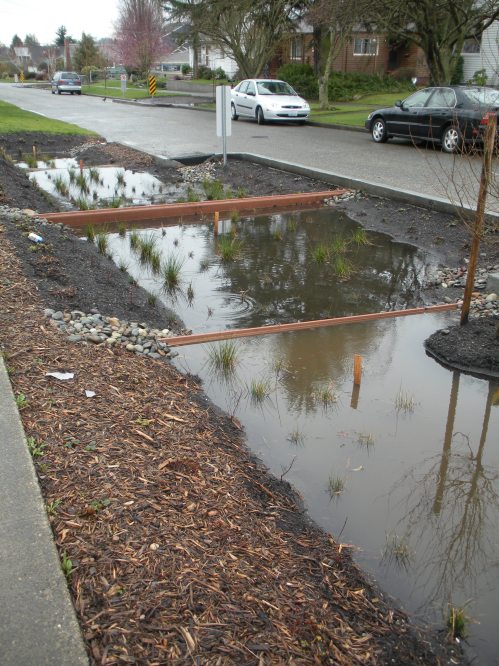Welcome
This site highlights the issues with the Ballard Roadside Raingardens Project, a.k.a. Ballard Raingardens.
Overview
This blog was started by residents affected by Ballard Roadside Raingardens project (Phase I) and now serves as a community information resource.
In Summer 2010, Seattle Public Utilities (SPU) began piloting Raingardens in the Ballard neighborhood (Seattle, WA) with the intention of expanding them to more locations in Ballard and the city. These Raingardens were a prototype with a new, atypical design: They were meant to hold large volumes of water and would not fully drain until after three rain-free days. For our experience, please see “Phase I Photos” and historical blog posts.
By Spring 2011, SPU decided to remove the Raingardens on 77th and 29th Avenues and eventually retro-fitted the Raingardens on 28th Avenue with under-drains.
Now SPU is moving to install Phase II, “Ballard Natural Drainage,” on blocks surrounding Loyal Heights Elementary school and Loyal Heights Community Center.
Please support our community, and go to the "Take Action" tab.
Location
Seattle's neighborhood of Ballard.Contact us
ballardraingardens@yahoo.comPosts
Comments
Comments pertaining to the Raingarden issues presented here are welcomed. The right to not approve comments that are disrespectful or impertinent to the issues is reserved.To note:
For the purpose of remaining consistent with SPU’s project title, we refer to these installations as “Raingardens.” However, since true raingardens drain naturally within 24 hours, more accurate terms are “bio-retention ponds” or “detention ponds.”Top Posts & Pages




















I am confused. What is the purpose of these “mud”” holes? I guess on the positive side of things, when my son falls into one and almost drowns I can sue….oh wait….that’s yet another negative. Well, way to go Ballard.
How can you possibly expect other homeowners to embrace a project that devalues their homes and changes their neighborhood into a commercial mud pit zone?
Also the issue of standing water is completely unacceptable. Rats? Mosquuitos? Children? Pets? Someone is going to drown in those. Cildren walk to and from their elementary school every day through this neighborhood. For the city to leave three feet of open standing water is very negligent.
I am shocked. This is just one more example of the city taking sides against what citizens want. No one is saying these are not necessary. But the beauty and sanctity of our neighborhoods, and the safety of our children are just as necessary. There is a way to make this work for everyone. Make them beautiful and take the bump outs off. it doesn’t seem like too much to ask.
One more interesting article, this one about accidental drowning. More kids die every year from drowning than guns! This one specifically calls out rain ditches around your home, and details that drowning is a sudden occurrence, it takes two minutes for a small child to drown and they can drown in as little as two inches of standing water!
http://kidshealth.org/parent/firstaid_safe/outdoor/water_safety.html
I’ve worked in public health and am very concerned about the lack of drainage in these raingardens for several reasons, many already mentioned. Whether these are not working due to lack of foresight of the physical inability of the gardens to drain or for other reasons, the facts speak for themselves and the gardens should be removed as a matter of public safety.
It does not appear that there has been a time when at least one of these gardens (or cells) did not have a significant amount of water in them. We are aware of the high risk of West Nile Virus from mosquitos and Public Health – Seattle/King County has been very active in educating the public about removing standing water around their houses, in flower pots, rain barrels, etc. Perhaps they should evaluate these raingardens for the risk factor of mosquitos breeding in all the standing water.
More concerning to me is the amount of standing water and the lure of playing in a “pond” that is so inviting to small children. Having such a liability in front of my house would be a weight I would be loathe to bear. I really feel for the neighbors on this street who have to consider so many negatives every time they see the raingardens remaining full of water.
I hope that the City realizes that it’s not too late to reevaluate the performance of these raingardens and sees that it has a responsibility to help this neighborhood maintain safety for its citizens.
Amazing, our forefathers worked their fannys off to drain standing water and eliminate mosquitoes then we create wetlands and rain ditches. This is a city not a swamp.
I must say, implementation should never come before adequate design study is done. These really do not resemble raingardens at least not compared to the ones I’ve seen constructed and been involved with installing. Has SDOT inspected the seriously dangerous drop off from the sidewalk edge? I can’t imagine they would overlook these areas that do not meet the City Standard Plan requirements for sidewalks. If the City wants to implement greener storm water management practices by retrofitting existing infrastructure they need to take each ROW, block by block as a whole study the amount of runoff, do the necessary calculations and design the size of gardens appropriately. In addition, SPU needs to go through the design review process and public comment period just like everybody else in my opinion. These are poorly designed, dangerous and clearly do not function as intended. These neighborhoods deserve better. I can see the West Nile threat just around the corner. Really poorly thought through. Horrible. I’ll keep my eye on this one.
It’s called a percolation test. Before a plot of land is determined to be suitable for use as a raingarden site, the underlying soil needs to be tested to see how readily it allows water to percolate down, as well as how quickly it becomes saturated.